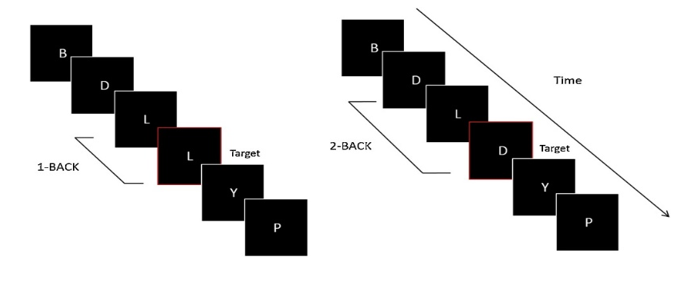One Step Backward: A Systematic Literature Review on the Use of N-Back Tasks to Increase Working Memory for Learner in SLA
DOI:
https://doi.org/10.51574/ijrer.v4i1.2555Keywords:
Learner, N-back Task, SLA, Working Memory CapacityAbstract
This literature review examines the role of working memory capacity (WMC) in second language acquisition (SLA) and explores potential solutions for learners with low WMC. Research shows that students with higher WMC perform better in vocabulary learning, oral fluency, and grammar. However, few studies offer strategies to help learners with lower WMC. The review highlights N-back tasks as a promising tool for improving working memory. Studies show that N-back training can enhance memory capacity but requires consistent practice for visible results. The researcher suggests incorporating N-back tasks to help students with low WMC improve their language learning skills.
References
An, H., & Li, S. (2024). The effects of planning type, working memory, and anxiety on L2 writing performance. Individual differences and task-based language teaching, 166-201.
Anjariyah, D., Juniati, D., & Siswono, T. Y. E. (2022). How Does Working Memory Capacity Affect Students' Mathematical Problem Solving?. European Journal of Educational Research, 11(3), 1427-1439.
Baddeley, A. D., Hitch, G., & Allen, R. (2021). A multicomponent model of working memory. Working memory: State of the science, 10-43.
Beukers, A., Hamin, M., Norman, K. A., & Cohen, J. D. (2024). When working memory may be just working, not memory. Psychological Review, 131(2), 563.
Burgoyne, A. P., Frank, D. J., & Macnamara, B. N. (2024). Which “working memory” are we talking about? Complex span tasks versus N-back. Psychonomic Bulletin & Review, 1-15.
Chingchit, O. (2024). The contribution of written corrective feedback and its association with working memory on the development of EFL learners’ English plurals. Language Teaching Research, 13621688241246134.
Chow, B. W. Y., Mo, J., & Dong, Y. (2021). Roles of reading anxiety and working memory in reading comprehension in English as a second language. Learning and Individual Differences, 92, 102092.
Coulacoglou, C., & Saklofske, D. H. (2017). Executive Function, Theory of Mind, and Adaptive Behavior. Psychometrics and Psychological Assessment.
Durand-López, E. M. (2024). Working memory training yields improvements in L2 morphosyntactic processing. Language, Cognition and Neuroscience, 39(6), 757-772.
Dziura, N., & Ślebarska, K. (2024). Memory dual N-back training using mobile devices and its effect on working memory capacity. Current Psychology, 1-11.
Forsberg, A., Adams, E. J., & Cowan, N. (2021). The role of working memory in long-term learning: Implications for childhood development. In Psychology of learning and motivation (Vol. 74, pp. 1-45). Academic Press.
Frost, A., Moussaoui, S., Kaur, J., Aziz, S., Fukuda, K., & Niemeier, M. (2021). Is the n-back task a measure of unstructured working memory capacity? Towards understanding its connection to other working memory tasks. Acta Psychologica, 219, 103398.
Fry, C. E., Langley, K., & Shelton, K. H. (2020). Executive functions in homeless young people: Working memory impacts on short-term housing outcomes. Child Neuropsychology, 26(1), 27-53.
Ger, E., & Roebers, C. M. (2023). The relationship between executive functions, working memory, and intelligence in kindergarten children. Journal of Intelligence, 11(4), 64.
Gagné, N., French, L. M., & Hummel, K. M. (2022). Investigating the contribution of L1 fluency, L2 initial fluency, working memory and phonological memory to L2 fluency development. Language Teaching Research, 13621688221076418.
Gilmour, G., Porcelli, S., Bertaina-Anglade, V., Arce, E., Dukart, J., Hayen, A., ... & Serretti, A. (2019). Relating constructs of attention and working memory to social withdrawal in Alzheimer’s disease and schizophrenia: issues regarding paradigm selection. Neuroscience & Biobehavioral Reviews, 97, 47-69.
Guo, A., Yang, W., Yang, X., Lin, J., Li, Z., Ren, Y., ... & Wu, J. (2023). Audiovisual n-back training alters the neural processes of working memory and audiovisual integration: Evidence of changes in ERPs. Brain Sciences, 13(7), 992.
Hamidnia, H. R., Habibzadeh, H., & Gharaei, Z. (2024). Working Memory Capacity and Contextual Novel Linguistic Input: A Cross-Modal Priming Study on Persian English Subordinate Bilinguals. Journal of Psycholinguistic Research, 53(5), 63.
Harvey, J. (2024). Exploring the Impact of Working Memory Capacity on Academic Reading and Achievement in South African Online Tertiary Students. Reading Psychology, 1-23.
Huang, T., Loerts, H., & Steinkrauss, R. (2022). The impact of second-and third-language learning on language aptitude and working memory. International Journal of Bilingual Education and Bilingualism, 25(2), 522-538.
Kargar Behbahani, H., & Razmjoo, S. A. (2023). The contribution of working memory and language proficiency to lexical gain: Insights from the involvement load hypothesis. Teaching English as a Second Language Quarterly (Formerly Journal of Teaching Language Skills), 42(3), 117-146.
Li, S. (2023). Working memory and second language writing: A systematic review. Studies in Second Language Acquisition, 45(3), 647-679.
Lin, W., Lv, C., Liao, J., Hu, Y., Liu, Y., & Lin, J. (2024). Feature versus object in interpreting working memory capacity. npj Science of Learning, 9(1), 67.
Ludyga, S., Gerber, M., & Kamijo, K. (2022). Exercise types and working memory components during development. Trends in cognitive Sciences, 26(3), 191-203.
Manchón, R. M., McBride, S., Martínez, M. D. M., & Vasylets, O. (2023). Working memory, L2 proficiency, and task complexity: Independent and interactive effects on L2 written performance. Studies in Second Language Acquisition, 45(3), 737-764.
Mason, G. M., Lokhandwala, S., Riggins, T., & Spencer, R. M. (2021). Sleep and human cognitive development. Sleep medicine reviews, 57, 101472.
Mateo, S. R. (2023). The Influence of Working Memory on Second Language Processing Outcomes of Language Learners. Psychology and Education: A Multidisciplinary Journal, 16(6), 1-1.
Muhammadpour, M., Hassanzadeh-Taleshi, M., & Salehi-Amiri, F. (2023). The effects of different task repetition schedules on oral narratives of L2 learners with high and low working memory capacity. Acta Psychologica, 236, 103933.
Naveh-Benjamin, M., & Cowan, N. (2023). The roles of attention, executive function and knowledge in cognitive ageing of working memory. Nature Reviews Psychology, 2(3), 151-165.
Peng, P., & Kievit, R. A. (2020). The development of academic achievement and cognitive abilities: A bidirectional perspective. Child Development Perspectives, 14(1), 15-20.
Perez, M. M. (2020). Incidental vocabulary learning through viewing video: The role of vocabulary knowledge and working memory. Studies in Second Language Acquisition, 42(4), 749-773.
Ruiz, S., Rebuschat, P., & Meurers, D. (2021). The effects of working memory and declarative memory on instructed second language vocabulary learning: Insights from intelligent CALL. Language Teaching Research, 25(4), 510-539.
Ruiz, S., Rebuschat, P., & Meurers, D. (2021). The effects of working memory and declarative memory on instructed second language vocabulary learning: Insights from intelligent CALL. Language Teaching Research, 25(4), 510-539.
Saed, N., & Awwad, A. (2024). L2 Proficiency and Working Memory As Predicted By Learners’implicit and Explicit Knowledge. European Journal of Literature, Language and Linguistics Studies, 8(3).
Salminen, T., Frensch, P., Strobach, T., & Schubert, T. (2016). Age-specific differences of dual n-back training. Aging, Neuropsychology, and Cognition, 23(1), 18-39.
Tang, N. (2021). Cognitive abilities, self-efficacy, and financial behavior. Journal of Economic Psychology, 87, 102447.
Teng, M. F., & Zhang, D. (2023). The associations between working memory and the effects of multimedia input on L2 vocabulary learning. International Review of Applied Linguistics in Language Teaching, 61(3), 1021-1049.
Teng, M. F., & Cui, Y. (2024). Comparing incidental learning of single words and collocations from different captioning conditions: The role of vocabulary knowledge and working memory. Journal of Computer Assisted Learning, 40(3), 973-989.
Thomassin, N., Gonthier, C., Guerraz, M., & Roulin, J. L. (2015). The Hard Fall Effect. Experimental Psychology.
Vanek, N. (2024). Working Memory and English Language Learning: Implications for Classroom-Based Research. In Cognitive and Educational Psychology for TESOL: A Guide for Practitioners (pp. 17-37). Cham: Springer Nature Switzerland.
Vu, D. C., Nguyen, T. V., & Kitjaroonchai, N. (2024). Exploring the Relationship Between Working Memory Capacity and L2 Oral Fluency. Theory and Practice in Language Studies, 14(7), 2002-2012.
Wiest, G. M., Rosales, K. P., Looney, L., Wong, E. H., & Wiest, D. J. (2022). Utilizing cognitive training to improve working memory, attention, and impulsivity in school-aged children with ADHD and SLD. Brain Sciences, 12(2), 141.
Yaple, Z., & Arsalidou, M. (2018). N‐back working memory task: Meta‐analysis of normative fMRI studies with children. Child Development, 89(6), 2010-2022.
Zhang, W., Liu, H., & Zhang, T. (2023). Immediate and short-term effects of single-task and motor-cognitive dual-task on executive function. Plos one, 18(8), e0290171.

Downloads
Published
How to Cite
Issue
Section
License
Copyright (c) 2025 ETDC: Indonesian Journal of Research and Educational Review

This work is licensed under a Creative Commons Attribution-ShareAlike 4.0 International License.








1.png)













